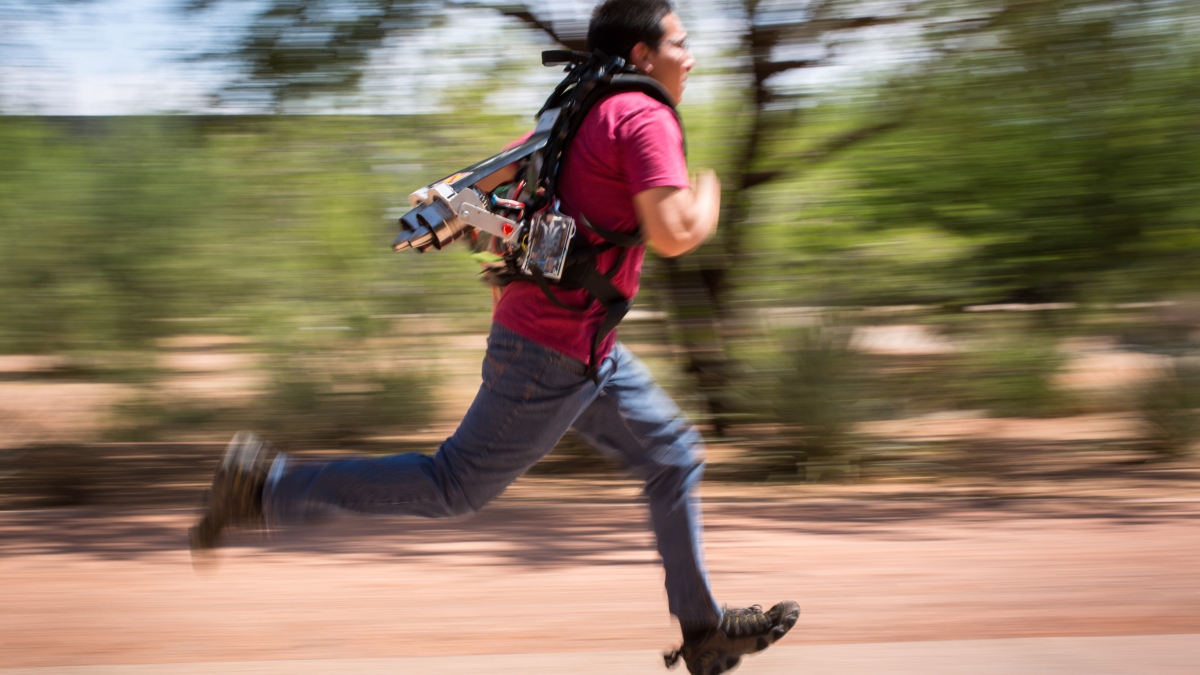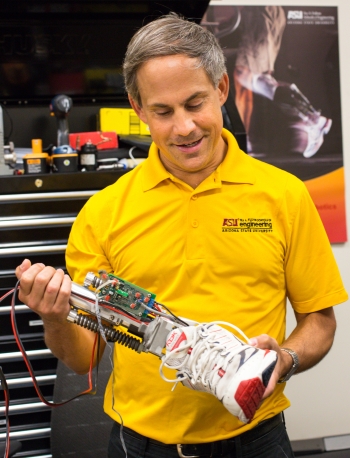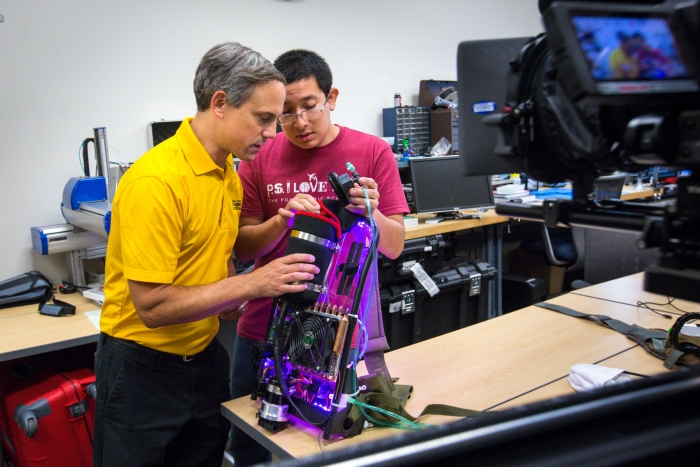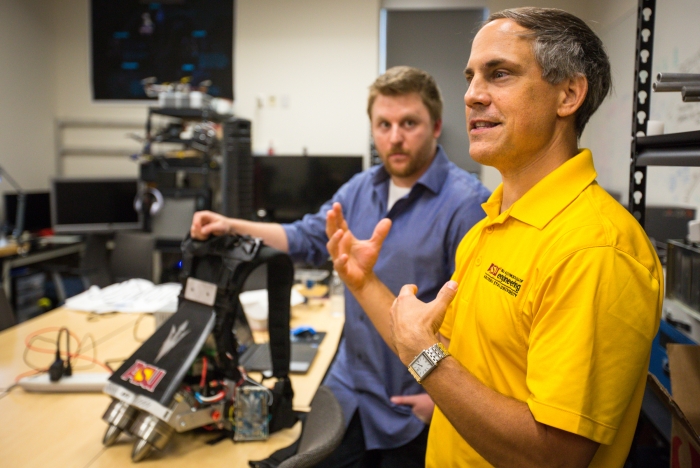Tom Sugar doesn’t consider himself a modern-day Iron Man, but he does marvel at how his specialty — wearable robotics or exoskeletons — has taken off and achieved something of blockbuster proportions. Sugar has worked in thethe field since 1999, when he first set up Arizona State Univesity’s Human Machine Integration Lab.
“I’ve never seen wearable robotics as hot as now,” said Sugar, a professor in the Ira A. Fulton Schools of Engineering at ASU’s Polytechnic campus. “When I was at the International Conference on Robotics and Automation, everyone was there — Amazon robotics, Google robotics and new companies like Robotis. The conference normally attracts 1,500 people. There were 2,700 this time. It’s just booming.”
That interest in exoskeletons has expanded at ASU too, which hired two new assistant professors in robotics for the Polytechnic campus and one for the Tempe campus. It's a far cry from the days when Sugar was the only robotics professor at ASU.
In his lab, a rectangular room that is part tech shop and part tinkerer’s paradise with gadgets, test instruments and tools strewn about, Sugar leads a team of ASU researchers and students in building devices to help people overcome a physical disability or provide enhanced performance.
Today, Sugar and his collaborators have five workable, wearable robotic systems and one that has graduated from the lab and moved on to commercial applications. The devices run the gamut, from a wearable jet-pack device that can boost a runner’s speed, to another backpack device designed to alleviate the physical stress of carrying a heavy load, to a small refrigerated suit to keep soldiers cool in a desert environment.
“The overall goal is to build a device that will augment or assist a user,” Sugar said of his exoskeletons. “It doesn’t have to be only for disabled people. It can be able-bodied people, soldiers, obese people or frail people.”
The challenge is to provide a benefit that outweighs the, well, weight that the device adds.
“Ninety-nine percent of the robots add weight, like 10 to 15 pounds for motors and batteries and sensors, but don’t pay for the weight penalty,” Sugar says. “So when you put it on, it’s actually harder to perform than when you are not wearing it.”
Sugar and his group have come up with two innovative designs that achieve “metabolic augmentation,” which means they overcome their weight gain and improve the user’s performance.

“There are only two groups in the world that have achieved metabolic augmentation. A group at MIT and us,” Sugar said.
Hanging on a rack in the lab is a device called Jet Pack, which is exactly what its name implies (though it doesn't involve flight). It has two small air jets that are strapped to the user’s back. Its design is to give a push to the runner, making his or her performance less taxing and improving overall run time. Developed as part of the military’s 4MM project (for four-minute mile), it provides up to 30 percent metabolic augmentation, but at a cost.
“It only lasts four to six minutes,” Sugar said. “At 24 volts and 100 amps, it just kills the batteries.”
Air Legs is a device that also can aid a runner, or help a hiker, or help somebody carrying a heavy load. It is much more efficient than Jet Pack in how it assists the user.
Air Legs is powered from a high-pressure air tank, similar to those used in paintball markers. The tank is charged externally, then mounted to the system. The system itself assists the user by pushing and pulling on the upper legs at precise intervals. It operates on a real-time control system that uses a phase controller to calculate the exact time to trigger the air solenoids. It demonstrated 10 percent metabolic augmentation at the Army Research Labs in September 2013.
A third exosuit hanging on the rack in the Sugar lab is the Cool Suit, which consists of a small refrigeration unit strapped to the back of a user. Developed for the Air Force, it circulates a cooled liquid across the upper body of the user. It was designed to aid soldiers in harsh, hot desert environments.
Yet another device, the pogo suit is designed to help a soldier carry his heavy backpack by oscillating the weight being carried. When you carry a 100-pound backpack while walking, it doesn’t move with your body but moves as a reaction to your movement. The idea of the pogo suit is to move the backpack with your natural rhythm of walking by oscillating the pack up and down as you walk, saving you energy in the process.
While they differ dramatically in what they try to do, each of these exosuits share a common trait. They deliver a mechanical assist to the user at a precisely timed interval.
“Timing is critical,” Sugar explained. “We use a phase controller so the user controls the robot, the robot doesn’t control the user.
“Say with Air Legs, if you are running and you give the force at the wrong time, the user will trip or fall. The assist must be delivered at precisely the right time or the gait will be off, and the metabolic process will shoot through the roof.”
DARPA funded
The majority of Sugar’s research is funded through the U.S. military. An early project was to develop a spring-loaded ankle for lower-leg amputees. Having such an ankle would give the user greater range in mobility and greater comfort than traditional prostheses that are simply strapped on and carried by the user. The Army was interested in such a device to get an injured soldier back to walking normally.
An early prototype was called SPARKy, for Spring Ankle with Regenerative Kinetics. That device was improved upon and resulted in Odyssey. Sugar and some of his students at the time helped create SpingActive, a company to commercialize the device. He said the group is on the cusp of delivering commercial devices for lower-leg amputees.
Though many of his projects have been funded through the military and the Defense Advanced Research Projects Agency (DARPA), Sugar said the future of wearable robotics is going to be commercial.
“The future will be a long consumer push into this arena,” Sugar said. “They are interested in building devices that can help you hike the Grand Canyon, or devices that help logistics companies for their workers making deliveries or working long hours in the warehouse.
“My belief is that the younger Baby Boom generation will want to stay active, and they like technology. They will wear these types of devices. So instead of a walker or a cane that assists, they might want to wear one of these devices.”
Education assist
Back in Sugar’s lab, ASU senior Eduardo Fernandez explains what Cool Suit means to him. Fernandez is something of a robotics prodigy. He first began tinkering with them while in middle school, and several Lego robotics competitions later, he made his way to ASU and Sugar’s lab.
“I used building robots as a way to motivate myself and learn more,” Fernandez said.
“This is my education,” he added. “In order to do the Cool Suit project I had to learn all of the thermodynamics before I even started, just to understand the way things work. Once I actually built it, the thermodynamics became much clearer. That’s when the lightbulb went off. The system is really simple and all of the math got simpler as well, because I understood what went on fundamentally.”
More Science and technology

ASU planetary scientist to be inducted into the National Academy of Sciences
The National Academy of Sciences is inducting School of Earth and Space Exploration Director Meenakshi Wadhwa into the 2023 class of new members for her pioneering work in planetary sciences and…
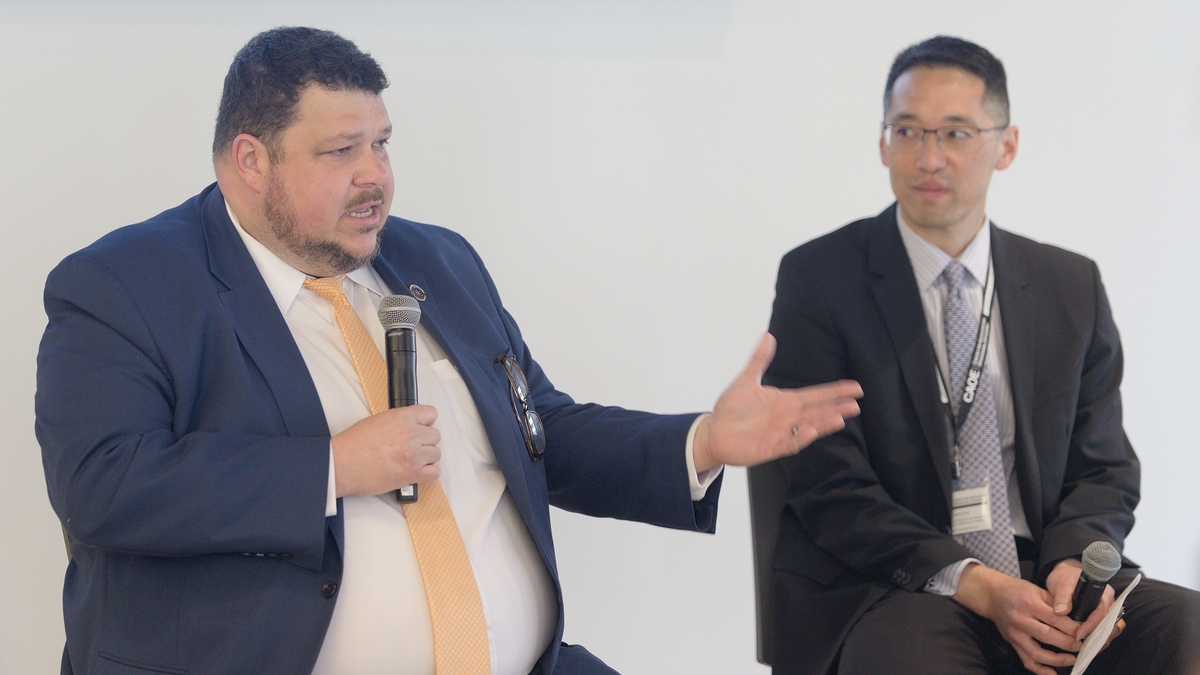
Unlocking the potential of AI for homeland security
“Can we do what we're doing now cheaper, more efficiently, more effectively?” Adam Cox, director in the Office of Strategy and Policy at the Department of Homeland Security Science and Technology…
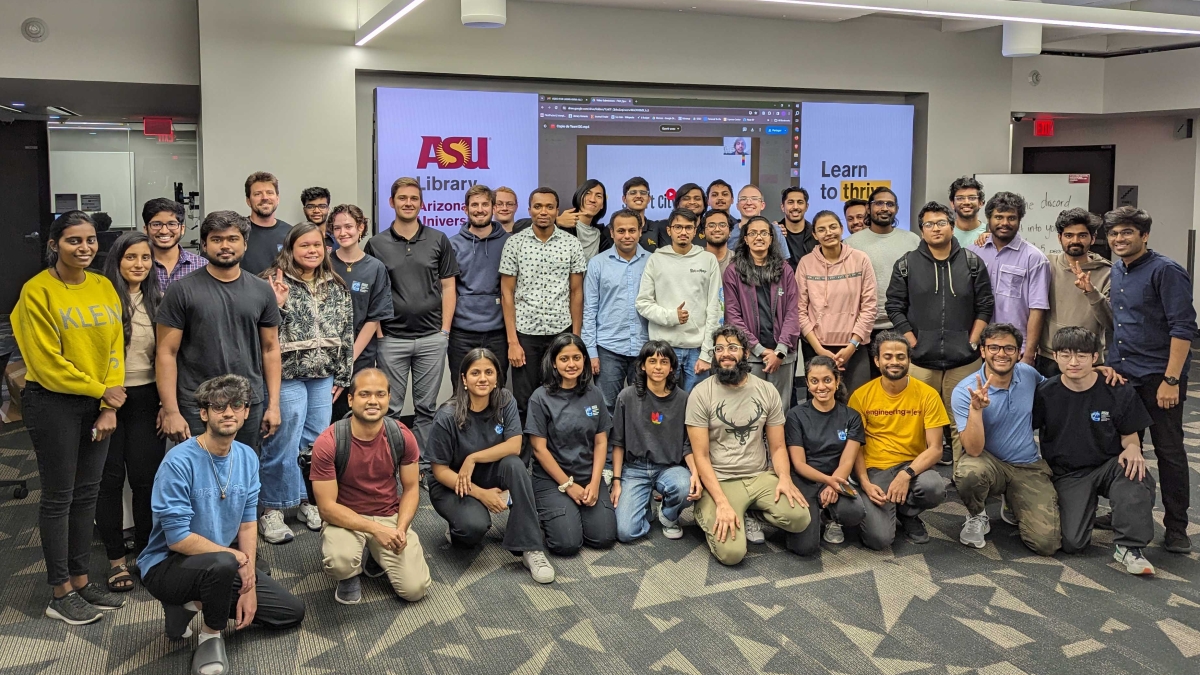
SpaceHACK highlights student solutions to environmental challenges, digital divide
By Adrianna Nine About 250 students from around the world convened online and at Arizona State University on March 22 for the ASU Interplanetary Initiative’s second annual SpaceHACK for…
